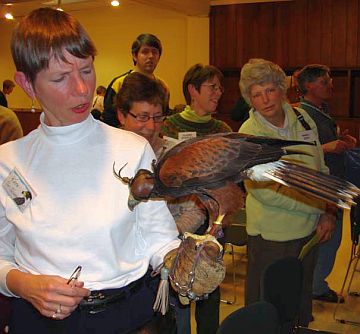 Last Wednesday, for the first time ever, I held a Harris’s hawk on my hand.
Last Wednesday, for the first time ever, I held a Harris’s hawk on my hand.
My opportunity came at the Three Rivers Birding Club meeting when master falconer Jeff Finch, president of the Pennsylvania Falconry and Hawk Trust, presented a program on falconry.
Jeff taught us about the rules and traditions of falconry, a hunting technique that’s at least 4,000 years old. In it, the falconer and his bird go to the field and look for prey. The falconer stirs up the prey, the bird flies to the kill. What they hunt depends on the bird’s natural hunting technique: ground-based prey (rabbits, squirrels, muskrats) for red-tails, harris’s and goshawks; ducks and pheasants for peregrines. Sometimes more than one prey item is caught per day but it doesn’t go to waste. The falconer brings it home to feed his birds throughout the year.
Falconry is hard work and a lifetime commitment, not only to train and care for the birds but to hunt with them all season – September through March. For falconers it’s a passion, a life-changing experience. We saw how falconers bond with their birds because Jeff brought his male American kestrel and female northern goshawk and master falconer Richie (I didn’t catch his last name) brought his Harris’s hawk.
The birds were gorgeous. It was such a treat to see them up close. Here I am holding the Harris’s hawk while Richie stands just outside the picture to the right. The hawk is wearing a falconry hood so you can’t see its face. (Click here for a better view of this species.) And don’t be fooled by my expression. My brows are knitted because I’m squinting. Those glasses in my right hand should be on my face!
Because of the peregrines, I have a special place in my heart for falconers whose passion, knowledge and breeding birds helped make the Peregrine Recovery Program such a success.
For more information on falconry in Pennsylvania, contact Jeff Finch at the Pennsylvania Falconry and Hawk Trust.
(photo by Mike Fialkovich)
An interesting story. I’m glad you told us about the falcon’s hood — its head looked like that of a weird insect. Does the hunting falcon bring back its prey in tact? Like, could the falconer have it for dinner?
Your Dad & I had a good chuckle over the glasses IN YOUR HAND! If it’s any comfort…all the youngsters we know (your age) do the same thing.
Love you.
I have never watched a falconry hunt but according to what Jeff Finch showed us, the birds kill the prey on the ground or they bring it to the ground as trained. At that point the prey is intact but the falconer has to come recover it or the bird will begin to eat. If the bird eats the prey, hunting is over for the day for both of them because the bird won’t hunt when his crop is full. An added hazard of allowing the bird to eat his fill in the field is that he will go roost and be very hard if not impossible to get to. Jeff Finch said kestrels normally carry their prey away so you have to run quickly to get to the kestrel while it’s still on the ground.
Thank you, Kate, for so generously sharing your experience with us. Your blog is like treasure found on the beach. When I’m up during the night dealing with health issues, your articles are good medicine.
Thanks for all you do, for all of us.
Hmm, I noticed the glasses in her hand too. Holding a falcon in one hand and glasses in another gives the impression of being comfortable.